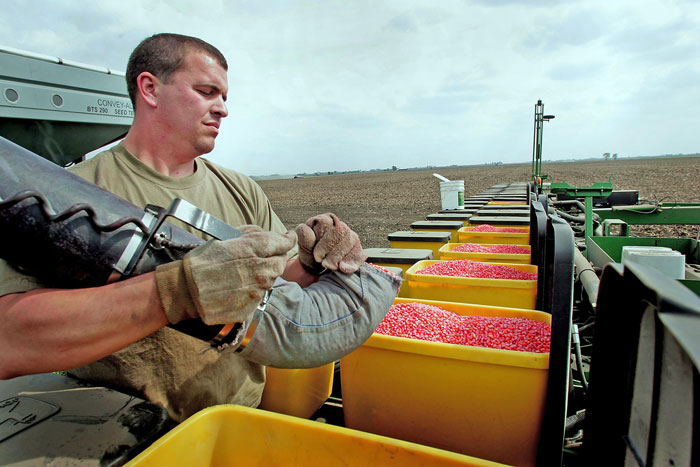
U.S. cotton acreage is projected to reach 9.56 million acres or 11 percent more than in 2015, which was the smallest U.S. cotton crop since the payment-in-kind-program year of 1983. Analysts have been expecting an increase in cotton plantings in 2016 because of the lower prices for competing crops.

U.S. farmers are expected to plant 93.6 million acres of corn this year, an increase of 6 percent from 2015 if they follow through on what they told USDA’s National Agricultural Statistics Service for its March 31 Planting Intentions Report.
Growers could also plant an estimated 82.2 million acres of soybeans, which would be down only slightly from 2015 when they were expected to plant a record 84.6 million acres. They actually planted 82.6 million acres, according to NASS.
The corn numbers caught most analysts, including USDA Chief Economist Robert Johansson, by surprise. Johansson had been predicting 90 million acres of corn for 2016 rather than the 93.6 million acres reported by farmers responding to USDA’s first crop production report survey of the year.
“Corn up by 5.6 million acres is a big number,” he said. Even with average yields “that would put us around 14 billion bushels for 2016 or a little bit above that with normal weather. Obviously, a lot can happen going forward but it’s hard to say right now what that will mean for expected prices.”
Near-term, corn futures fell, partly due to the higher acreage forecasts and also because USDA forecast corn stocks of 7.8 billion bushels, as of April 1, which would be the second highest on record.
11 percent more cotton acres
U.S. cotton acreage is projected to reach 9.56 million acres or 11 percent more than in 2015, which was the smallest U.S. cotton crop since the payment-in-kind-program year of 1983. Analysts have been expecting an increase in cotton plantings in 2016 because of the lower prices for competing crops being offered for 2016.
The 5.6-million-acre increase in corn plantings forecast for 2016 would put U.S. corn acres at their highest level since 2013. The 93.6 million would also be the third-largest U.S. corn acreage planted since 1944.
Not surprisingly to those who have watched the shift to corn in the Mid-South the largest percentage increases are expected in the states of Arkansas, Louisiana and Mississippi. Arkansas’ corn acres could rise from 2015’s 460,000 to 790,000; Louisiana’s from 400,000 to 730,000; and Mississippi’s from 510,000 to 800,000.
Whether Louisiana’s total will reach that level is subject to question because of the unusual amounts of rain that have fallen there in recent days. “Many fields were flooded for quite some time, and some of them are still holding water,” says Dan Fromme, Extension corn specialist for Louisiana. “Obviously, those fields will have to be replanted.”
Regardless of the weather problems, U.S. farmers are expecting to have an ample supply of corn by the end of the 2016 harvest,” said National Corn Growers Association President Chip Bowling.
Ample corn supplies for 2016
“While many factors may change the reality on the ground as planting progresses, American corn supplies should remain ample for the year to come. Given the impact this continues to have on prices, the work being done at NCGA to grow demand will prove even more important as we work to find markets for our product and remain profitable into the future.”
Of the major corn-producing states, the largest increases in planted acreage are expected to be in Kansas, North Dakota, Iowa and Illinois. No major corn-producing states expect decreases in acreage from what was planted in 2015.
The biggest decline is occurring in the U.S. wheat crop, which is forecast at 49.6 million acres, a 9-percent decrease from 2015. The winter wheat crop, at 36.2 million acres, is down 8 percent from last year and down 1 percent from earlier estimates.
U.S. rice producers are expected to increase their plantings by 17 percent to 3.06 million in 2016, again because of the lack of good prices for alternative crops. See http://deltafarmpress.com/rice/robert-coats-analysis-usdas-2016-prospective-planting-report
Of the rice-producing states Mississippi is expected to have the largest percentage increase of 47 percent from 150,000 to 220,000 acres followed by Texas at 42 percent from 133,000 to 189,000 acres.
Grain sorghum acreage dropping
The Mid-South’s move to grain sorghum also appears to be abating with USDA predicting milo acres will fall 15 percent from 2015’s 8.46 million to 7.22 million acres. Grain sorghum plantings are expected to decline by 69, 14 and 58 percent in Arkansas, Louisiana and Mississippi from 2015 to 2016.
Acreage for the crop increased significantly last spring because grain sorghum could be contracted at a premium to corn after China began importing significant amounts of it rather than buy GMO corn.
With the slowdown in Chinese economic growth and the buildup of its own stocks, Chinese officials have been buying smaller amounts of almost every commodity the U.S. farm sector sells.
Peanut plantings are also forecast to decline across the U.S. with growers seeding 1.48 million acres, down 9 percent from 2015’s 1.63 million. Observers had expected peanut acres to remain high due to more favorable provisions for peanuts in the 2014 farm bill.
To view today’s USDA report, visit http://www.usda.gov/nass/PUBS/TODAYRPT/pspl0316.pdf.
About the Author(s)
You May Also Like





